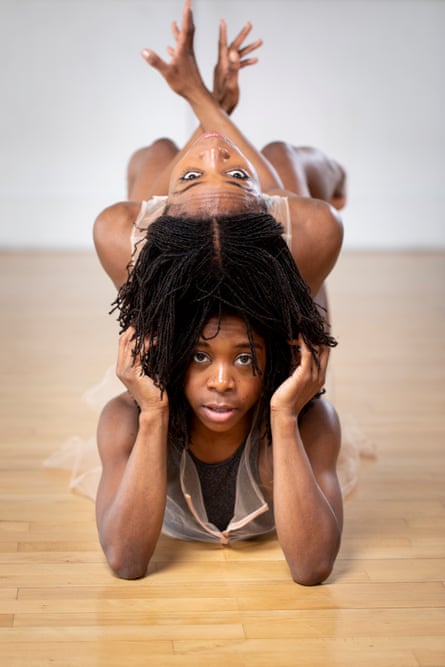In the summer of 2012, Kristina and Sadé Alleyne’s Olympic dream came true. It just wasn’t the dream they’d imagined. As teen athletes, they’d had their eyes on the 100m sprint. By the time 2012 rolled around, they made it to the Olympic stadium all right – but as dancers in the opening ceremony, performing with choreographer Akram Khan to the sound of Emeli Sandé singing Abide With Me.
It was an unexpected swerve for the London twins – but that night in the stadium convinced them they’d done the right thing. “We’d made the decision on instinct,” says Kristina, “and the fact that we made it to the Olympics through dance, it showed us...” Sadé picks up: “… we were meant to be there.”
Their background in athletics has turned the identical twins into powerhouse dancers, with all that fast-twitch, straight-out-of-the-blocks combustion that sprinters have. They’re two of the most striking dancers you can currently see, bursting with dynamism and guillotine-sharp precision. On stage, they’re absolutely fearless, their movement encompassing the energetic force of hip-hop, the detail and rhythm of kathak, and the earthy weight and sinuous curves of African dance.
Having toured the world with Akram Khan, the 31-year-olds are now pursuing a wealth of projects, including making work for their own company, Alleyne Dance, and others, as well as performing at this year’s Brighton festival in TrapTown, a multimedia mash of dance, film, music and theatre on the subject of conflict and myth, cooked up by Belgian provocateur Wim Vandekeybus.
The twins’ move into dance was almost accidental. Growing up in Enfield (with a plasterer father, a mum who worked for FedEx, and an older brother), they trained at Enfield and Haringey Athletics Club. At school, they were self-confessed geeks who would compete to finish first in tests. When Sadé won a maths prize, she was offered the chance to take any course she wanted, and chose dance. “I don’t know why,” she says. “I think they were handing out flyers.”

The pair ended up going to the Brit school in Croydon, and then discovering hip-hop with east London company Boy Blue. It was a shift in priorities and, while they had fitness and strength, they were lacking many dancers’ qualities. “We were so ungraceful,” laughs Kristina. “When we started dance we said, ‘Are we really going to try to make this a career? I can’t even touch the floor!’ We had to change our bodies a lot.”
They trained at the Northern School of Contemporary Dance but then took a conscious decision to follow separate paths for a while, Sadé to Birmingham to pursue Afro-Caribbean dance (their family hails from Barbados), Kristina to explore Belgium’s contemporary dance scene. They would discuss who was going to go to which audition, portioning out the jobs like Tony Blair and Gordon Brown at Granita. But they’d always share what they’d learnt.
Having a second self to go and do fieldwork for you is, it seems, just one of the advantages of dancing with your twin. “We always had someone to bounce off,” says Sadé. “It’s harder to motivate yourself when you don’t have anyone. That’s how we’ve always worked as sisters, pushing each other. We were each other’s teacher, which was really suffocating sometimes, but we were also each other’s support system.”
In their own work, they do a lot of lifting, balancing and manipulating of each other’s bodies, which turns out to be tricky when your instincts are so similar. “When we improvised, we kept doing the same thing, so we kept clashing,” says Kristina. “I’d try to go under Sadé’s arm, and she’d do the same. One of us had to give. Both of us want to lift, but one of us has to give and be lifted. It’s been a process.” It’s like that classic twin trope of turning up in the same outfit (one they’ve amusingly reproduced in their piece Testimonies) but in dance form.
They don’t always think the same way, they insist, but often they do. “I won’t even have to finish my sentence,” says Sadé, “but it’s annoying because I would like to finish my sentence.”
Yet those frustrations are a small price for the connection of dancing with someone you know so well. “I trust her 100% on stage,” says Kristina. “I know if something’s going wrong we can go with it.”
They both like to take risks, the feeling of being on the edge. “We’ve got this saying: ‘The bird who dares to fall is the bird who learns how to fly,’” says Sadé. “And we live by that.”
“It’s like passing the baton in the relay in athletics, where you’re reacting in the moment,” adds Kristina. “I have that feeling with Sadé. That’s why I always want to perform this way.”
TrapTown is at Brighton Dome, 21 May. Alleyne Dance perform at DanceEast, Ipswich, 24 May.

Comments (…)
Sign in or create your Guardian account to join the discussion